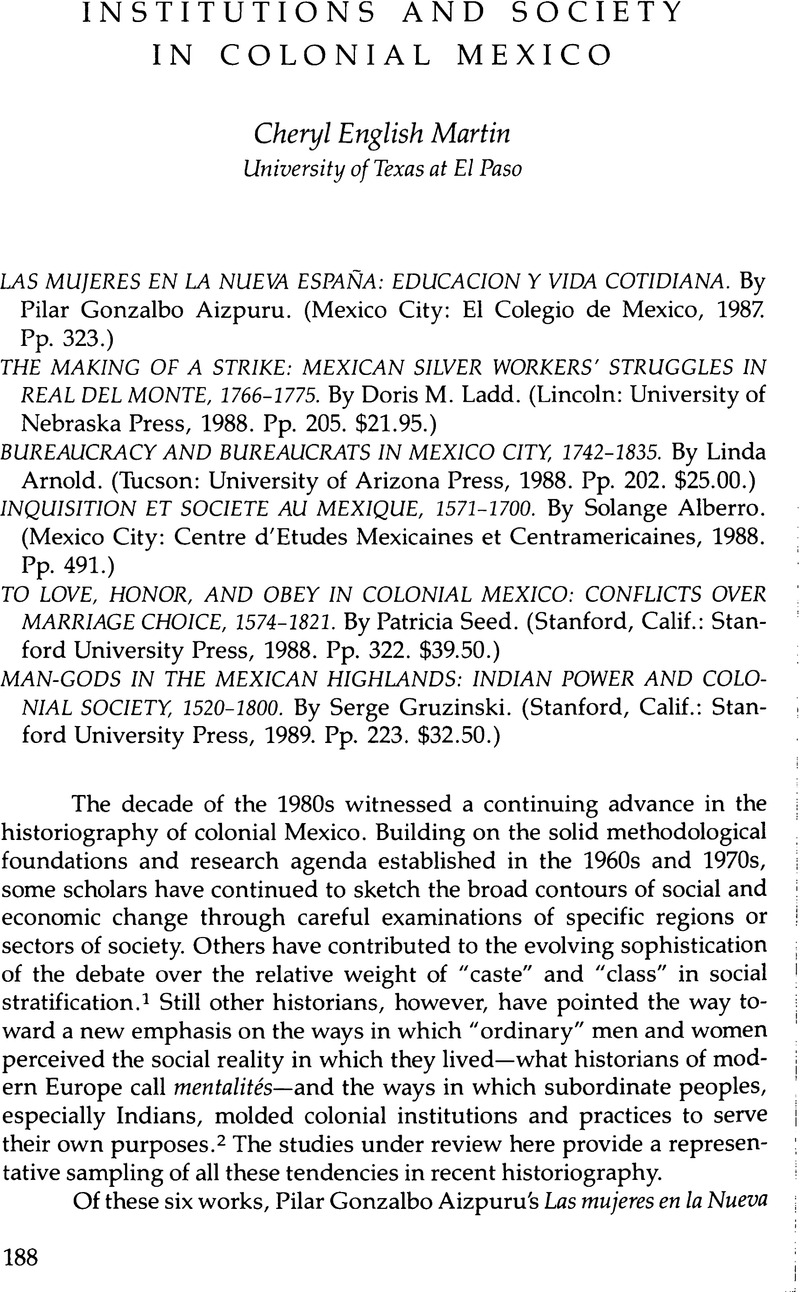No CrossRef data available.
Article contents
Institutions and Society in Colonial Mexico
Review products
Published online by Cambridge University Press: 12 October 2022
Abstract

- Type
- Review Essays
- Information
- Copyright
- Copyright © 1990 by the University of Texas Press
References
Notes
1. For excellent reviews of recent historical scholarship on colonial Latin America, see Rodney Anderson, “Race and Social Stratification: A Comparison of Working-Class Spaniards, Indians, and Castas in Guadalajara, Mexico, in 1821,” Hispanic American Historical Review 68, no. 2 (May 1988):209-44; John Kicza, “The Social and Ethnic Historiography or Colonial Latin America: The Last Twenty Years,” William and Mary Quarterly, 3d series, vol. 45, no. 3 (July 1988):453-88; Eric Van Young, “Recent Anglophone Scholarship on Mexico and Central America in the Age of Revolution,” Hispanic American Historical Review 65, no. 4 (Nov. 1985):725-44; and Eric Van Young, “Mexican Rural History since Chevalier: The Historiography of the Colonial Hacienda,” LAR 18, no. 3 (1983):5–62.
2. See, for example, William B. Taylor, Drinking, Homicide, and Rebellion in Colonial Mexican Villages (Stanford, Calif.: Stanford University Press, 1979); Nancy M. Farriss, Maya Society under Spanish Colonial Rule: The Collective Enterprise of Survival (Princeton, N.J.: Princeton University Press, 1984); and Robert S. Haskett, “Indian Town Government in Colonial Cuernavaca: Persistence, Adaptation, and Change,” Hispanic American Historical Review 67, no. 2 (May 1987):203–31.
3. Asunción Lavrin, “Ecclesiastical Reform of Nunneries in New Spain in the Eighteenth Century,” The Americas 22, no. 2 (Oct. 1965): 182–203; Lavrin, “In Search of the Colonial Woman in Mexico: The Seventeenth and Eighteenth Centuries,” in Latin American Women: Historical Perspectives, edited by Lavrin (Westport, Conn.: Greenwood, 1978), 23–59; Silvia Arrom, The Women of Mexico City, 1790-1857 (Stanford, Calif.: Stanford University Press, 1985); Josefina Muriel, Los recogimientos de mujeres: respuesta a una problemática social novohispana (Mexico City: Universidad Autónoma de México, 1974); and Luis Martín, Daughters of the Conquistadores: Women of the Viceroyalty of Peru (Albuquerque: University of New Mexico Press, 1983).
4. Steve J. Stern, “Feudalism, Capitalism, and the World-System in the Perspective of Latin America and the Caribbean,” American Historical Review 93, no. 4 (Oct. 1988): 829–72, 856–57, n. 72; and review by John Kicza, Hispanic American Historical Review 69, no. 1 (Feb. 1989): 164–65. In 1730, workers in Chihuahua fought and ultimately lost a similar struggle over the issue of the partido. See Cheryl E. Martin, “Labor Relations and Social Control in Eighteenth-Century Chihuahua,” paper presented to the American Historical Association, Chicago, 27–30 Dec. 1986.
5. Susan Socolow, The Bureaucrats of Buenos Aires, 1769–1810: Amor al Real Servicio (Durham, N.C.: Duke University Press, 1987).
6. For previous scholarly work on the Mexican inquisition, see such examples as Richard E. Greenleaf, The Mexican Inquisition of the Sixteenth Century (Albuquerque: University of New Mexico Press, 1969); and Stanley Hordes, “The Crypto-Jewish Community of New Spain, 1620–1649: A Collective Biography,” Ph.D. diss., Tulane University, 1980.
7. See, for example, Carlo Ginzberg, The Cheese and the Worms: The Cosmos of a Sixteenth-Century Miller, translated by John Tedeschi and Anne Tedeschi (New York: Penguin, 1982); and Robert Darnton, The Great Cat Massacre and Other Episodes in French Cultural History (New York: Basic Books, 1983).
8. Van Young, “Recent Anglophone Scholarship”; Darnton, The Great Cat Massacre; and John Demos, Entertaining Satan: Witchcraft and the Culture of Early New England (Oxford: Oxford University Press, 1982).
9. Serge Gruzinski, Les Hommes-dieux du Mexique: Pouvoir indien et société, XVe–XVIIIe siècles (Paris: Editions des Archives Contemporaines, 1985).
10. Van Young, “Millenium on the Northern Marches: The Mad Messiah of Durango and Popular Rebellion in Mexico, 1800–1815,” Comparative Studies in Society and History 28, no. 3 (July 1986):385-413; and Van Young, “Quetzacoatl, King Ferdinand, and Ignacio Allende Go to the Seashore; or Messianism and Mystical Kingship in Mexico, 1800–1821,” in The Independence of Mexico and the Creation of the New Nation, edited by Jaime E. Rodríguez 0. (Los Angeles: UCLA Latin American Center and the Mexico/Chicano Program, University of California, Irvine, 1989), 109–28.
11. For a fuller discussion of this approach, see William B. Taylor, “Between Global Process and Local Knowledge: An Inquiry into Early Latin American Social History,” in Reliving the Past: The Worlds of Social History, edited by Olivier Zunz (Chapel Hill: University of North Carolina Press, 1985), 115–90.




